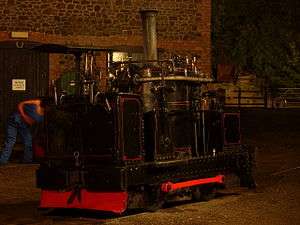Chaloner (locomotive)
%2C_2008.jpg)

0-4-0VBT Chaloner is an example of de Winton's distinctive vertical-boilered design, as used for many years in the North Wales slate quarries. It was built in 1877 at the Union Works in Caernarfon. (The former de Winton factory is located across the road from the present WHR station). It is believed to have been supplied new to the Pen-y-Bryn slate quarry, Nantlle, moving to Pen-yr-Orsedd nearby in 1888. It was obtained for preservation by Mr A Fisher and is normally based at the Leighton Buzzard Narrow Gauge Railway.
Chaloner was a visitor to the Ffestiniog Railway for the 150th Anniversary Celebrations in 1986. It returned in October 1986 for an overhaul at Boston Lodge, including fitting of a new boiler. Another of a number of visits was the Festival of Steam Gala, May 1997.
It visited the Welsh Highland Railway (Porthmadog) around 1989 and 1998, and in 2006 visited the Welsh Highland Railway (Caernarfon). Another visit was made in 2011.[1]
The locomotive was used to haul the opening train of the 'Iron Horse Railroad' at Leighton Buzzard in 1968. The railway later became the Leighton Buzzard Narrow Gauge Railway. Though in poor condition it hauled trains there for several years until replaced by more powerful engines needed for longer trains. It was housed at the National Railway Museum in York from 1977 until 1983. It has received a new boiler fitted at Boston Lodge Works but apart from that is composed of entirely original material, making it unique among mid-Victorian locomotives. The newest part is the water tank which originated on a locomotive called 'Victoria' and dates from 1897. It has been successively improved since preservation and is now (2018) in fine condition. In 2011 it worked a train of two slate wagons and members from Caernarfon (opposite the works where it was built) to Porthmadog on the Welsh Highland Railway a distance of twenty five miles achieving speeds over well over 20 m.p.h. on the flat. A week later it worked to Blaenau Ffestiniog and back with slate wagons. Replacement of valves of the correct size and other adjustments since then have seen further improvements to performance affecting economy.
During its display in the old de Winton works in Caernarfon a works photograph was produced showing the engine as built with a basic cab. A replica of this was built which worked but made conditions difficult for operating and it was removed and placed in store after two years.
She has visited 24 other railways, including some in France, Germany and Belgium.
References
De Winton of Caernarfon, by Alfred and David Fisher and Gwynfor Pierce-Jones. R.C.L. Publications, 2011